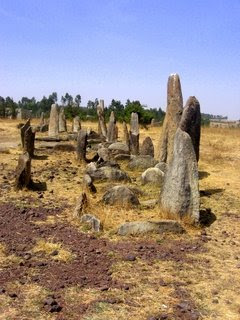Last week for the first time, I took the public bus from Butajira to Yetebon, the 8 kilometer trip on a bumpy dirt road. The public buses only run on market day, every Friday. Generally, we're blessed to have dependable transportation at Project Mercy, making the weekly trip on the back of an Isuzu truck. All the teachers and hospital staff do their market shopping, while us "ferengis" (Scott and me) visit the internet café.
On this particular Friday, the Project Mercy transport was delayed and we were anxious to get back for a church program. Our options were a gari, which is a horse cart, or the public bus. I had observed these buses the past several months…usually a big mob of people loaded down with their market purchases, fighting for a space on the overcrowded minibuses. It's not exactly an appealing scene, but still I wanted to experience "real life" in Yetebon.
So Scott and I headed to the area where the buses line up, along with Bedru, a 12th grade student from the school here. Bedru helped us identify a bus going on the direction of Project Mercy. We were fortunate to be the first people on the bus, therefore getting the "choice" seats in the front of the bus. The first thing to catch my eye were the gaudy decorations in the front windshield…flower garland, photos of icons signature of the Ethiopian Orthodox church, and a curtain to block out the sun for the driver and his front passenger.
It only took about 7 minutes for the bus to fill up. Most were men. The fee is 3 birr (about 35 cents), making it cost-prohibitive for the women, who must use the little money they have to pay for food and goods for their family. Men can be, and are, more superfluous with their money. The women are the ones who really need the ride, loaded with market purchases on their back. Rarely will you see an Ethiopian man carrying anything other than a walking stick and a bundle of chat, a narcotic plant that is a major cash crop in Ethiopia. The leaves are chewed to get a high.
I had seen these buses from the outside, and knew that they filled them well beyond capacity. But being a part of the spectacle from the inside gave a whole different perspective. Thankfully, the market purchases were stowed on the top of the bus. So, no chickens or goats boarded with us, though there were a few stalks of sugarcane that threatened to take someone's eye out. People kept packing in. I got a quick count of the seats before the bus filled…there were 24. I did not get a complete headcount, but in front of the first row of seats there were 10 people. My estimation was that there were at least 50 people on that bus. Once the aisle filled, the bus turned into a "double-decker" as at least one man perched himself on top of a seatback.
As if a ferengi doesn't stand out enough with their white skin…I looked around at a sea of neutral-colored clothes, while I was decked out in a red top and loud floral skirt. I'm not exactly sure what made me notice this. Then I pondered to myself why people here don't wear any color. Maybe their clothes had been colorful at one time, but the wear and dusty roads they traverse turn them all to shades of brown. Or maybe it's not worth having colorful clothes because it's only a matter of time before they become brown. Anyway, market day is not the ideal time to go out dressed in one's finest.
The bus driver was a gruff sort of character. Bedru told us he was high on chat, but not to worry…chat is a stimulant, but it doesn't impair one's vision.
The people sitting (or standing) near me were very friendly. They tried out their English on me, saying "Yes I can" and "thank you", then smiling proudly. They were high on chat, too.
This bus had a lot of character… and the horn spoke of the rough life it has led. The best way I can describe the sound is an old lady's cackle who had smoked all her life. I chuckled every time it let out a rough, shrill hoot. The donkeys along the way weren't really phased by it…but then again, what are they phased by?
It's remarkable that this generated so much to write about, considering it was only a 20 minute ride covering just 8 kilometers! I'm not eager to repeat the experience, but I survived and now appreciate life here a little more.










